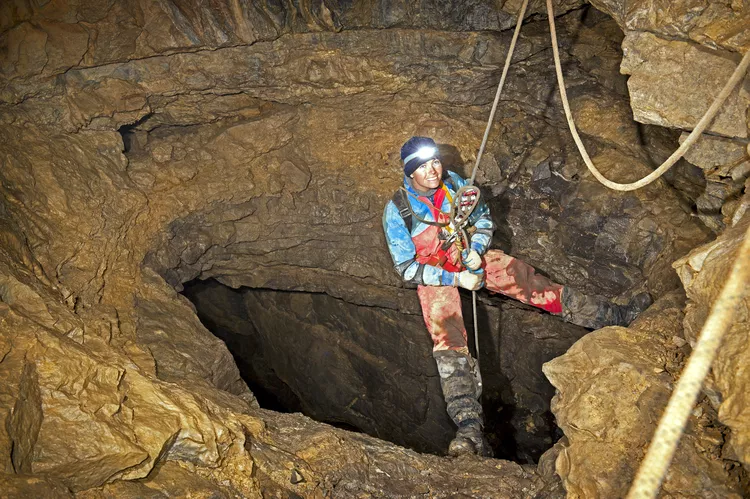Caving Equipment Guide
It’s important to have the right caving equipment to enjoy your underground experience to the max. Caving clothing is warm, dry, and lightweight, and proper caving equipment, like helmets and headlamps, is essential for safety and fun.
Proper Spelunking Gear Makes Caving More Fun
Many novice caving trips can be undertaken in ordinary, albeit old, clothing. Cheap waterproof rain pants and jackets or cotton coveralls can serve as top layers. However, for prolonged and adventurous caving trips, investing in durable caving equipment and clothing is highly recommended. You’ll stay warm and dry, thereby enjoying your expedition far more than if you were to wear old blue jeans and a flannel shirt.
Rent or Borrow Gear to Start
If you’re a beginner caver or are simply curious about the underground world, reaching out to a local spelunking club is a great first step. You’ll find enthusiastic guidance and may also have the chance to rent or borrow basic caving equipment from members. Moreover, some outdoor retailers—particularly in regions like Derbyshire, England’s Peak District—offer equipment rentals including helmets, headlamps, and belts.
Caving Equipment Depends on Where You Cave
The essential caving equipment varies by region. For example, the gear you need for caves in Colorado or Kentucky will differ significantly from that required in Great Britain. Environmental conditions in caves can vary wildly between regions and countries, thus emphasizing the importance of using the appropriate caving equipment. Seek out local expertise and assistance on caving equipment whenever possible.
Caving Tests Your Gear’s Endurance Limits
Choose gear, equipment, and clothing specifically designed for caving whenever feasible. While you might manage in easier caves with subpar equipment, more challenging caving environments will put your gear to the test. Consequently, nothing is more inconvenient than losing your fanny pack because its buckles fail halfway through an underground passage, forcing you to turn back.
Don’t Use Climbing Equipment
It is generally inadvisable to use climbing equipment for caving. Climbing harnesses, for instance, are not built for caving and may wear out or fail under the harsh conditions found in caves. Using a climbing harness while caving is akin to employing inadequate tools for a critical job. Likewise, avoid using climbing belay devices, ascenders, and climbing ropes in vertical caves. Instead, opt for caving-specific racks or stop devices for safety.
Basic Caving Equipment
- Helmet – Essential for head protection and mounting your headlamp. Always wear a helmet when caving.
- Headlamp – A vital piece of caving gear for visibility in dark locations. Avoid headlamps with elastic headbands; instead, mount the headlamp on your helmet.
- Back-up Headlamp – Bring a spare headlamp along with other light sources to avoid being stuck in the dark underground.
- Footwear – Sturdy boots with good rubber soles are crucial, as you will encounter rocky terrain. Cavers in the UK often wear calf-high Wellington boots, while many American cavers prefer high-quality hiking boots.
- Caving Undersuit – A quality fleece undersuit helps keep you warm and dry.
- Wet Suit – Necessary for extended periods of wet conditions underground.
- Oversuit – An abrasion-resistant one-piece coverall is vital for crawling in tight spaces.
- Waist Belt – A small waist belt or fanny pack for carrying batteries and personal items.
- Socks – Start with wool socks but consider neoprene socks for serious cavers.
- Headwear – A thin balaclava or skull cap for added comfort under your helmet.
- Knee Pads – Essential for crawling; either neoprene or heavy-duty miner’s kneepads are recommended.
- Elbow Pads – Not mandatory but can protect your oversuit during long crawls.
- Gloves – Industrial rubber gloves are helpful in wet and slimy passages.
- Tackle Bag – A waterproof bag for keeping gear and supplies dry.
- Harness – If a harness is necessary, choose a specialized caving harness. Avoid climbing harnesses.
- Chest Harness – A specific chest harness is crucial for ascending fixed ropes underground.
- Ascenders – Use specialized caving ascenders like Petzl Croll.
- Descenders – Opt for caving-specific descenders like the Petzl Stop or Rack for safety.
- Cow’s Tails – Utilize accessory cords with carabiners for anchoring and rope connections.
- Food and Drink – Bring energy drinks, water, or hot beverages along with energy bars for nutrition on your caving adventures.





